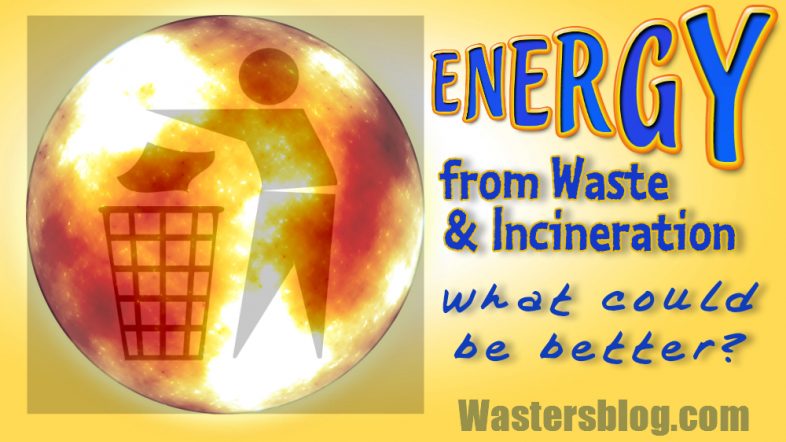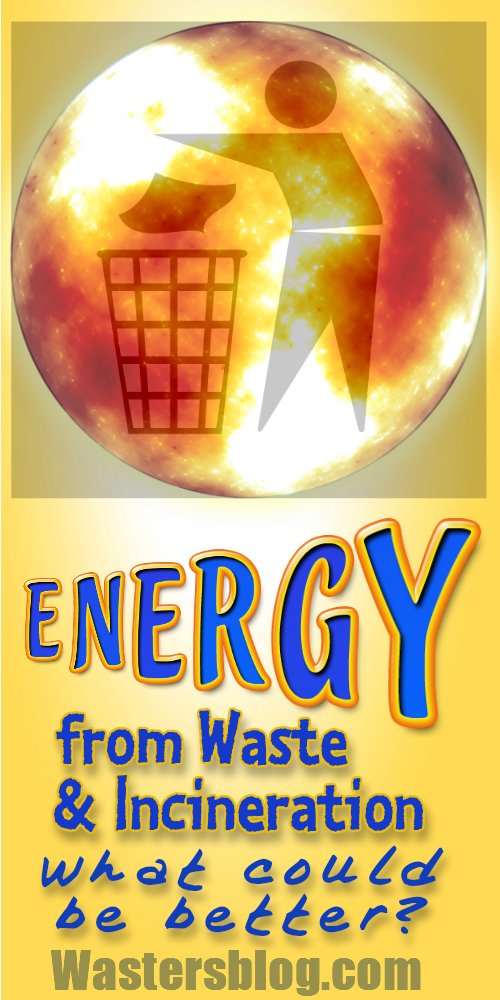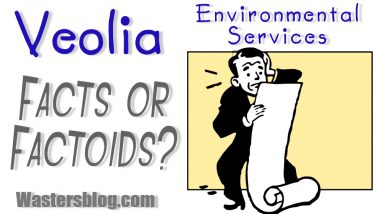 Producing energy from waste and incineration are very popular, for MSW treatment, with incineration the most used. The term ‘energy from waste‘ (EfW) covers a wide variety of combustion processes that reclaim energy from a waste material feedstock.
Producing energy from waste and incineration are very popular, for MSW treatment, with incineration the most used. The term ‘energy from waste‘ (EfW) covers a wide variety of combustion processes that reclaim energy from a waste material feedstock.
It in particular refers to treatment processes that harness the calorific value in waste to generate electrical power or heat. This is then distributed with the rest of our “non-renewable” and “fossil fuel” derived energy through the electricity grid network.
“Don't Write Incineration Off Yet! – But It's Not the Best!”
Using energy which would have been lost if it had been placed in a landfill. EfW energy production uses an otherwise largely wasted resource.
“Incineration serves to cut-back the volume and weight of the original waste which would otherwise have gone to landfill, leaving only a small residue that requires disposal.”
[box type=”info” style=”rounded” border=”full”]Update for Autumn 2018: Since this article was published EfW Plants have been proving very popular throughout the UK. They are the single most popular type of waste process now being used in the UK.[/box]
Energy from Waste/ Incineration Produces One of the Highest Mass Reductions of the Residual Output of All the Waste Technologies
These plants, in the form of incineration plants, are actually capable of reducing the volume of waste. They reduce it by as much as ninety percent, and they reduce the weight by seventy five percent.
The incineration process is actually just about the most efficient at this. The ash that's left may also be made excellent use of in construction materials/ recycling applications.
This ability of incineration to reduce volume and mass is very good. But, is not nowadays as effective as it once was, when emissions to atmosphere were less strongly regulated.
This is due to the need for sophisticated methods to be used to clean up incinerator flue gases, before they can be emitted. This is due to the modern air-pollution control-systems which provide this function. If some of the most popular flue-gas pollution-abatement processes are used, these create additional waste materials.
In other words, the air pollution control systems most often used in incineration plants produce waste of their own. This needs further treatment or disposal. This may have to be sent to a specifically approved (permitted) “hazardous waste” landfill site.
It is hoped that flue-ash created by these technologies will soon be treated and used as a product. This would remove at-a-stroke, all problems of waste disposal of incinerator fly-ash. (Update 2018: Nowadays some technique do indeed, now allow flue-ash to be sold as a product!)
Alternative (and Better) Strategies to Incineration
A number of alternative strategies to incineration have just recently been developed for recovering EfW, including combustion, gasification, pyrolysis and biological processes, e.g. anaerobic digestion and the extraction of landfill gases. The quest continues for better EfW processes which:
- avoid creating polluting gases and toxins in order to reduce the need for costly and energy consuming flue gas clean-up technology
- are highly effective in reducing the volume and mass of the residue
- if not particularly good at reducing volume and mass of the incoming waste, to provide a valuable non-toxic product (e.g. anaerobic digestion produces biogas and a fertilizer).
Despite much work having been done in developing alternative EfW technologies to incineration, the commonest kind of EfW is using incineration technology, and the majority of new capacity (e.g. in the UK) is being installed as incineration processes.
How Energy from Waste Using Incineration Technology has Developed
Incineration came first. It means burning residual waste ( generally after separation for recycling and composting ) in furnaces and which incorporate a boiler and generator system to supply an electricity output from the steam produced. The heat may be exploited in district heating systems (known as CHP). The technology itself is really flexible, and can process mixed municipal wastes and other waste streams, including clinical and industrial wastes.
Other newer processes pelletize waste inputs for burning in a refuse derived fuel ( RDF ) plant. The UK Governing Body has outlined RDF as ‘turning the flammable portion of waste, e.g. paper and plastics, into a fuel which can on occasion be stored and transported, or immediately used on site to provide heat and / or power.
RDF gives the operator the opportunity to store energy and choose to generate power when it is needed the most – a rare attribute among renewable energy processes.
A key development of EfW has been through the development of environmental technology and regulation. During the last 20 years the emissions from EfW plants have been seriously reduced through progressively enhanced regulation, and improved use of flue gas treatment technologies.
Throughout Europe the older generation of incineration plants have all been closed or upgraded to meet the 1996 EU emissions directive and the further reinforced EC Incineration Directive emissions regulations came into effect in 2004.
Incineration Technology No Longer Held Back by Flue Gas Emissions Concerns
There are no longer any reasons to hold back any EfW plants due to concerns about gas emissions. The science surrounding what constitute emissions risk to human health are now well known.
The UK and EU legislation has been set at a level which guarantees the health of all those who work in these plants, or live nearby.
Why Not Forget Other Ways to Use Municipal Solid Waste – Just Burn the Lot!
The idea of using incineration alone, being simply to burn the materials until there is nothing left to combust, has its limitations.
Other processes can produce useful products.
“When materials which can be re-used/ recycled, they should be.”
For this reason many people would like to see a bigger uptake of the alternative (new) waste technologies, like recycling through materials recovery facilities (MRFs), gasification, pyrolysis and also making better use of biological processes.
Only Burn Material that can't be Beneficially Used – The Waste Hierarchy and Sustainable Waste Management
The best action to take when deciding the best way to act sustainably, and make best use of waste materials, is enshrined in the “waste hierarchy”. Since 2000, major advances have been made in developing plant and equipment to apply the “waste hierarchy” effectively.
Unfortunately, although there's been a major level of interest in developing new plants which will utilize these 'emerging ‘ waste treatment technologies (e. g. pyrolysis, gasification etc.). And, these will ultimately become essential to help the all EU nations meet their duty.
They all have a duty to reduce their dependence on landfill dumping of waste/ comply with the requirements for carbon emissions reduction. These facilities are still expensive and demand high levels of skill to develop and operate.
Some suggest (written in March 2012) that UK many EfW plants will be needed that can handle between ninety thousand and six hundred thousand tonnes of waste every year. Facilities like these can produce between 6 and 40 MW of electricity.
There was in 2004, enough capacity in energy from waste plants then operating, to provide 203MW of power from UK EfW facilities, which process has a grand total throughput of just about 3,000,000 tons of community solid waste (MSW) every year.
Substantial extra UK EfW (incineration) capacity for MSW has been installed since then (written in 2012), and further plants are in the planning stage. The result has been that installed EfW capacity has more than doubled, since 2000.
Correspondingly the power now being generated from previously landfill-dumped municipal industrial and commercial solid waste has also increased.
If the New Waste Treatment Technologies are More Sustainable, Why Not Just Use them Right Now?
The reason that the more recently developed waste technologies than thermal treatment/ energy from waste, are not being built in bigger numbers lies in their newness.
By this we mean that investors find it hard to take on-board the bigger risk from new processes. They will want to stay with the tried and tested techniques used in incineration. In the current recessionary economic period (2011 -12) these new-tech processes might, or might not, make a profit.
“The current unstable “immature” markets for most recyclates is a relevant cause for concern.”
Will it really be possible to produce essential income from the sale of their products (e.g. compost or say “bio-char”), over the next 10 years? Many potential investors in new waste treatment technologies doubt the stability of these recycled material markets.
Conclusion to “What Could be Better than Energy from Waste and Incineration?”
(Written in 2012.) All nations should do their utmost to gain as much value from our wastes as practical, instead of continuing historical dependence on landfilling. The argument for this is compelling for minimizing use of finite materials resources, and avoiding groundwater pollution.
The sole use of incineration to create energy from waste may seem attractive, but should be avoided for all but the most difficult waste to re-use and recycle. Ignoring this would result in an unsustainable rate exhaustion of natural resources.
In the future after the waste management industry must remove as many valuable materials from the waste as feasible, like paper, glass and plastics, in accordance with the “waste hierarchy”. The residual waste which results, will still contain valuable energy, and can be incinerated. That will help reduce unwanted emissions of carbon from fossil fuels, and replace coal or oil burning.
“Incineration alone is no solution to the sustainability problem.”
The United Kingdom lags behind its Western European neighbours in recovering energy from waste. But, it is pleasing to note the accelerating number of energy from waste facilities now being built and the number of further projects in the pipeline. If these go-ahead this will soon make the UK one of the leaders in EfW adoption.







Proper recycling is better. Incineration results in laziness because the local authority can just chuck everything into the incinerator and not bother to recycle. I bet they do that all the time.
Hello. Energy from Waste and Incineration is often spoken of badly. Residents don’t want it near them, and environmentalists denegrate it, but in an imperfect world this is unfair, and fails to appreciate the dedication of the staff who proudly operate these facilities. There are a lot of merits to incineration. Make no mistake.
Thanks, Ralf Hartsock